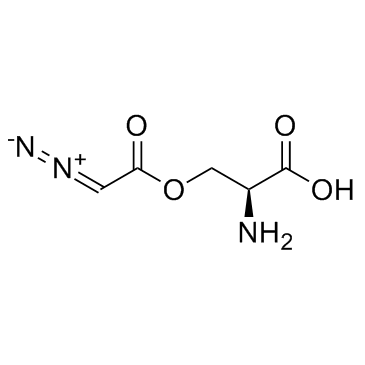Azaserine

Azaserine structure
|
Common Name | Azaserine | ||
|---|---|---|---|---|
| CAS Number | 115-02-6 | Molecular Weight | 173.127 | |
| Density | N/A | Boiling Point | N/A | |
| Molecular Formula | C5H7N3O4 | Melting Point | 146-162° (dec) | |
| MSDS | Chinese USA | Flash Point | N/A | |
| Symbol |


GHS06, GHS08 |
Signal Word | Danger | |
|
Generation of potent mouse monoclonal antibodies to self-proteins using T-cell epitope "tags".
MAbs 7(1) , 129-37, (2015) Immunization of mice or rats with a "non-self" protein is a commonly used method to obtain monoclonal antibodies, and relies on the immune system's ability to recognize the immunogen as foreign. Immunization of an antigen with 100% identity to the endogenous ... |
|
|
The LIV-I/LS system as a determinant of azaserine sensitivity of Escherichia coli K-12.
FEMS Microbiol. Lett. 237 , 73-77, (2004) The growth of Escherichia coli is inhibited by an antibiotic compound, azaserine (O-diazoacetyl-L-serine). Previous studies revealed the biochemical properties of azaserine, which involves inhibition of various enzymatic reactions as well as introduction of D... |
|
|
Identification and characterization of genes related to the production of organic acids in yeast.
J. Biosci. Bioeng. 113(5) , 556-61, (2012) Organic acids contribute to the flavor of many foods and drinks including alcoholic beverages. To study the cellular processes affecting organic acid production, here we screened collections of Saccharomyces cerevisiae deletion mutants and identified 36 yeast... |
|
|
The hexosamine biosynthesis inhibitor azaserine prevents endothelial inflammation and dysfunction under hyperglycemic condition through antioxidant effects.
Am. J. Physiol. Heart Circ. Physiol. 296(3) , H815-22, (2009) Hexosamine biosynthetic pathway (HBP) accounts for some cardiovascular adverse effects of hyperglycemia. We investigated whether the HBP inhibitor azaserine protects against hyperglycemia-induced endothelial damage dependently of HBP. Human endothelial cells ... |
|
|
Glutamine-induced protection of isolated rat heart from ischemia/reperfusion injury is mediated via the hexosamine biosynthesis pathway and increased protein O-GlcNAc levels.
J. Mol. Cell. Cardiol. 42(1) , 177-85, (2007) It has been shown that glutamine protects the heart from ischemia/reperfusion (I/R) injury; however, the mechanisms underlying this protection have not been identified. Glutamine:fructose-6-phosphate amidotransferase (GFAT) regulates the entry of glucose into... |
|
|
Glutamine analogs promote cytoophidium assembly in human and Drosophila cells.
J. Genet. Genomics 38 , 391-402, (2011) CTP synthase is compartmentalized within a subcellular structure, termed the cytoophidium, in a range of organisms including bacteria, yeast, fruit fly and rat. Here we show that CTP synthase is also compartmentalized into cytoophidia in human cells. Surprisi... |
|
|
Azaserine, DON, and azotomycin: three diazo analogs of L-glutamine with clinical antitumor activity.
Cancer Treat. Rep. 63(6) , 1033-8, (1979) A review of the clinical data on azaserine, DON, and azotomycin reveals that these agents have limited but definite antitumor activity. All three drugs are analogs of L-glutamine and contain a diazo group. They have been studied as single agents in a wide var... |
|
|
Expression of cholecystokinin-2/gastrin receptor in the murine pancreas modulates cell adhesion and cell differentiation in vivo.
Am. J. Pathol. 165 , 2135-2145, (2004) The presence of gastrin and cholecystokinin-2 (CCK2) receptors in human preneoplastic and neoplastic gastrointestinal lesions suggests a role in cancer development. In addition to the growth-promoting action of gastrin, recently a role of the cholecystokinin-... |
|
|
Nitrogen-15 NMR studies of nitrogen metabolism in Picea glauca buds.
Plant Physiol. Biochem. 42(10) , 803-9, (2004) In vivo (15)N nuclear magnetic resonance (NMR) as well as (15)N solid-state magic angle spinning (MAS) NMR spectroscopy were used to investigate nitrogen metabolism in cultured white spruce (Picea glauca) buds. Long-term as well as short-term experiments were... |
|
|
Exogenous ammonium inhibits petal pigmentation and expansion in Gerbera hybrida.
Physiol. Plant. 133(2) , 254-65, (2008) Petal pigmentation is the most important aspect in natural flower coloration. In the present study, the inhibition of petal pigmentation by exogenous ammonium was investigated. Ray floret petals detached from inflorescences of Gerbera hybrida (Shenzhen No. 5)... |